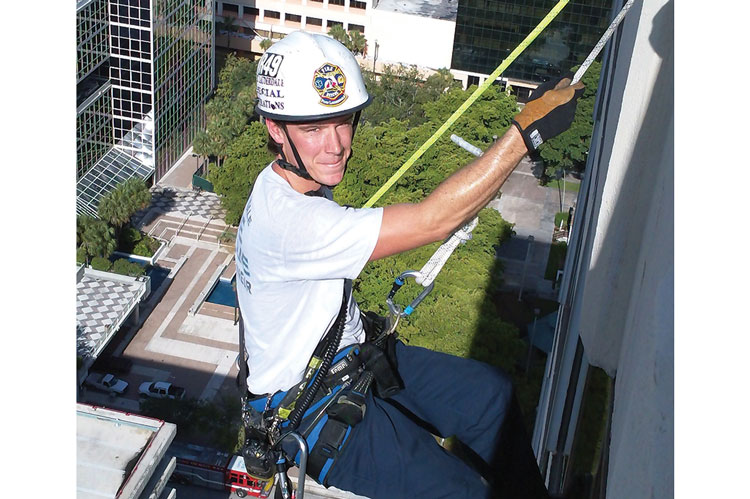
By Jeremy Rifflard
Technical rescue teams (TRTs) may be called out to execute a low-frequency/high-risk response to a patient trapped at an elevated location, in a confined area, or on steep terrain. The responders must have knowledge, skills, and ability to execute the complex rescue. TRTs should internally assess their team to determine if the team is prepared to attempt the rescue. Part of this internal team evaluation is to review the knowledge of the rescuers and the equipment available for use. There must be sufficient rope hardware and ropes to lower the rescuer and retrieve the patient.
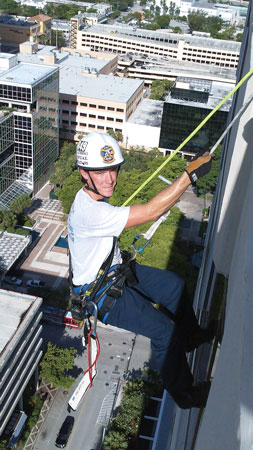 |
| (1) The Fort Lauderdale Technical Rescue Team practices lowering a rescuer from a 300-foot-high target hazard. (Photos by author.) |
The team must have several life safety ropes of various lengths available for immediate deployment. The most common diameter static kernmantle rope used by civilian and military urban search and rescue (US&R) teams is ½ inch, which has a tensile strength of 40 kilonewtons (kN) and is resistive to just less than 9,000 pounds of force. Knowing the overall distance of the rescue (from the technical rescue preplan) is vital to determine the rope length needed.
Rope Length for Elevated Victim Rescue
The overall length of the rope should be at least the vertical distance of your longest potential rescue plus rigging distance from the vertical edge to the farthest anchor. I add a 20 percent “oops factor” to determine the overall length of the main rope needed. For the safety of the rescuer and the patient, a second belay rope and system must be placed in service as part of the rescue plan. The same length rope will be needed for the belay operation. It is a good practice to double these main and belay rope lengths to add a second rescuer that can aid the primary rescuer should an emergency occur. When possible, measure the distance of your potential rescue situations during the technical rescue preplan phase.
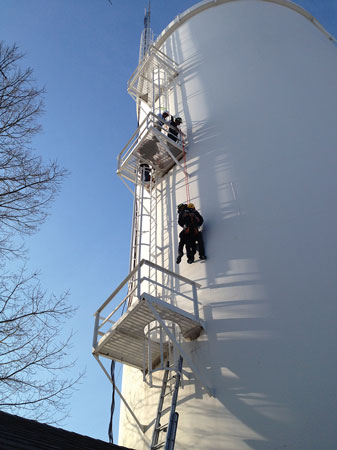 |
| (2) Storage containers are target hazards for a rope rescue. Workers can fall onto their lifelines. In this photo, Murray, Kentucky, firefighters are practicing a pick-off. |
Preplanning
Preplanning your elevated structures, which include high-rise buildings, water towers, upright bridges (my department responded to three bridge rope rescues in the past four years), storage tanks, large ships in port, blind elevator shafts, silos, and steep natural terrain, will aid in determining the length of rope needed to make the rescue. If you do not have the proper length of rope, the rescue may be beyond your capabilities; in that case, summon another TRT.
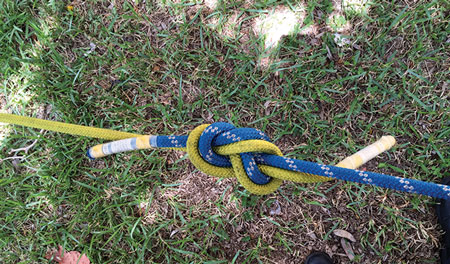 |
| (3) The figure 8 bend. |
The technical rescue preplan allows you to find the anchors when the pressure and cameras are not focused on your team’s actions. Repeatedly climbing up and down in search of anchors gives the observers an impression that the elevated rescue is beyond your team’s capabilities, increases the time before the patient is rescued, and delays the delivery of advanced medical care.
Determine your anchors before the rescue occurs. Are there sufficient anchors on the roof of the structure? Do you need to go into the stairwell or on the floor below to locate an anchor? Are there rough structural components that need to be padded to protect the extended rope anchors?
Scenario: 100-Foot Storage Tank Will two ropes 200 feet in length allow you to make the rescue?
The victim has a back injury. He is on top of a storage tank that is 100 feet above the ground. The round storage tank is 100 feet across in diameter. Your team inspects the tank and finds no suitable elevated anchors. The TRT operations leader determines that you will use the fire truck you responded with as the anchor for the rope system. How much rope will you need?
Computation. You will need the following:
- 100 feet of rope to lower the victim to the ground.
- More than 100 feet from the apparatus to the top of the storage tank, based on how close the fire truck is parked near the tank to extend your anchor to the rigging area. If it is parked 20 feet away and you need 120 feet for this part of the formula, you will need 100 feet to cross the top of the storage tank.
- You decide you can get away with 30 feet of rope to construct a lowering system. This totals 350 feet of rope length.
- Add another 20 percent of rope length in case the estimates are off. If the 100-foot measurements were really 120 feet, you just added 60 feet of length to the equation. That is the “oops factor.” Using these figures, the 120-foot-tall storage tank could require a main and a belay rope that are each 410 feet in length. Does your team have more than 800 feet of life safety rope to readily deploy? Do you have another 800 feet of rope to deploy a second rescuer on main and belay systems?
Preplan your rope system with anchors, rigging, and rope length. I call the length of the rope from the rigging to the ground “the operational section of the rescue.” Use the longest length of continuous rope for the operational section of the system. These ropes must be free of knots to simplify the rescue. If your ropes are too short to reach from the rigging to the ground, you will need to overcome this obstacle. Your team must gain rope length by tying two or more ropes together.
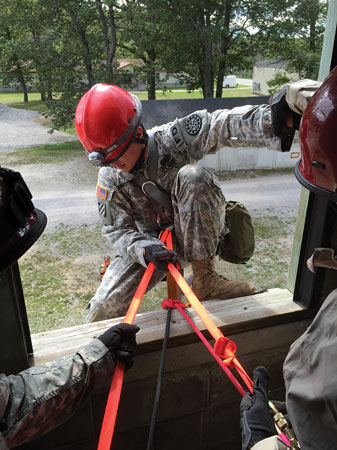 |
| (4) This United States Army rescuer is being assisted onto the rope system with a 25-foot webbing that is run through his D ring. |
The rope rescue technique to join two ropes with equal diameter is the figure 8 bend (photo 3). To tie the figure 8 bend, tie one rope as a simple figure 8 stopper knot. The second rope will retrace the first pattern following from the end of the rope to four to six inches beyond the knot. Follow the standard of your jurisdiction relative to the need of a safety knot on the tail of the figure 8 bend.
Tying two ropes together will create a knot that must be passed around the components of a lowering or hauling system. The knot is usually too large to pass through a standard pulley, tandem prusik cords, or a bar rack. To pass the knot through a system, use a load release device to hold the rope with the knot in place. When the load is transferred to the load release device, remove the hardware from the rope and relocate it to the opposite side of the knot. After a safety check of the system, the load release can be activated to transfer the load back onto the rope. This is a highly technical and time-consuming process. Avoid knot passing by using longer ropes or devices that can pass knots.
What do you do if you have only one rope long enough to make the rescue and the other ropes are too short to span the entire distance?
Place the rope that is long enough in service as the main line. In this situation, two ropes must be tied together to create the needed length for the belay rope. The knot joining the ropes may need to pass through the hardware of the belay system. It will be easier to pass the knot through the belay system components because they are not under tension during the normal operation of the main lowering or hauling systems.
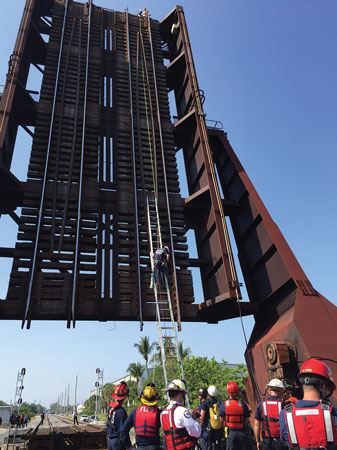 |
| (5) Fort Lauderdale firefighters ascend a rope on a bridge to secure a person who is stuck at the top. Rope rescues can occur anywhere. Use creativity in preplanning for incidents. |
What are the advantages of including 25-, 50-, or 75-foot lengths of ½-inch “short ropes”?
Technical rescue teams should have a complement of short ropes along with several long ropes. One of the best uses of short ropes is to extend your main or belay anchors (photo 4). Roof anchors are often on the farthest side from your departure point. Machinery on a rooftop and other incident noise can make verbal communication between the TRT operations leader and the rest of the team difficult to comprehend. The extension of anchors can bring system operators closer to the edge person who communicates with the team. Short ropes are excellent for extended anchors; they keep your long ropes available for the operational section of the system.
When a rescuer is climbing onto a stokes basket lowering line from a window or roof with no high anchor, there is a short period when the rescuer is climbing down by his own abilities without a lowering system. A short rope or webbing, about 25 feet in length, can be used to control attendants onto a rope system. The short rope or web can be anchored to the lowering line with a rope grab. The end of the rope can pass through the attendant’s D ring, which creates a 2:1 mechanical advantage. This will control the descent onto the lowering line. Once the rescuer is secured to the system, the short rope or web can be pulled through the D ring and moved out of the way. Using this device to lower the rescuer prevents shock loads on the rope system.
Wrapping building structures may take more length than what your anchor straps will provide. Rope may be needed to anchor to a structure. If you need 60 feet of rescue rope to wrap an anchor around a protruding roof stairwell, you do not want to take a 200-foot life safety rope out of play to do this. This task is best accomplished with a shorter 75-foot rope.
 |
| (6) Rescuers from Puerto Rico Metro Two are using short ropes as guy lines to stabilize ladder movement. |
Scaffold rescue situations necessitate rescuing the trapped workers and securing the unstable platform. There are several issues to consider: Are the victims of the scaffold collapse suspended on their lifelines? Are the workers attached to a worn life line that their weight has tensioned on a building’s metal drip edge? Is the rope across a rough concrete wall? You may want to use a short rope that secures the life line. The rope should grab the life line below the drip edge and be secured to a stable elevated anchor. This short rope will support the worker in case his life line breaks.
You may want to use rope to secure a precariously angled scaffold. This is common in a scaffold anchor failure. When one scaffold anchor fails, the weight is doubled on the remaining anchor (photo 5). Two short ropes can complete the task. Wrap one rope around each end of the scaffold. It should be tensioned to hold the scaffold in place.
Short ropes can be used to stabilize other vertical structures or work platforms. They can act as guy ropes to keep a work platform from tipping. Guy ropes can be attached to tripods, gin poles, or elevated points such as when two ladders are tied together (photo 6).
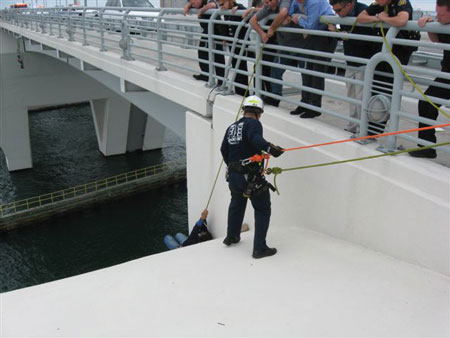 |
| (7) The short rope attached to this rescuer will provide fall protection as he assesses the patient who is on the ledge of the Fort Lauderdale 17th Street Bridge. Without fall protection, the rescuer could fall 100 feet into the waterway. |
Are you lowering a stokes basket off a roof with no parapet or railing? If your team members are operating near a vertical edge, they must have fall protection (photo 7). Each rescuer must be in a harness that is tied back to an anchor that will prevent them from falling off the roof. The rope fall protection should be positioned to limit movement of personnel extending over the edge. The anchor chosen for this system must be solid to resist shock loads from the rescuer’s tripping or leaning too far over the edge. Leaning over the edge is common when manipulating a stokes basket into position.
During the size-up of a person needing rope rescue, you may find that the anchor is not in line with the departure point where you must access the patient. Your system may need to be redirected with a directional anchor. To redirect from the anchor to the departure point, use a pulley applied to the operational rope. The pulley is attached to a short rope that pulls the rope until it is in line with the desired departure point. This is another opportunity to use a short rope that extends from a directional anchor to the departure point that lines up with your victim (photo 8).
Earlier, I discussed a load release device used to aid when passing a knot. One of the most common old-school load-release techniques is to construct a mariner’s hitch between your anchor and a point beyond the system components. The mariner’s hitch has a limited throw, which is usually twice the length of the device.
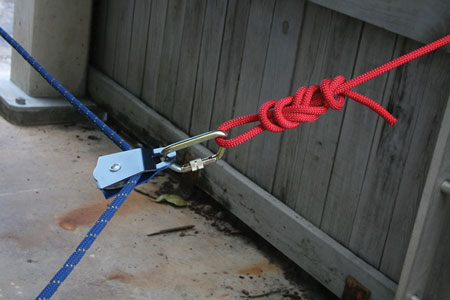 |
| (8) A directional (or redirectional) anchor. |
Another load-release technique is to use a short rope secured around a rescue eight plate with ears. The knot end of the short rope will attach to a grab device that will hold the main rope, which has a knot in it. The extension of the load release is limited only by the length of your rope and the workable space of your rescue. If a 50-foot short rope is used for the load transfer, you can extend this rope about 45 feet as compared to the six-foot length that the mariner’s hitch typically extends.
The concept that one rope length will meet every need of the TRT is flawed. Rescue teams should have immediate access to short and long life safety ropes. One pitfall is to use short trench panel ropes for life safety needs. Avoid this. Trench panel ropes are often downgraded life safety ropes that have been cut short. They may have been cut because of age or damage to a portion of the rope. When a rope is downgraded, it can never be upgraded for life safety use.
TRTs must evaluate their team’s abilities and equipment and their response area’s structures. The preplan should uncover potential rescue equipment needs. Part of the preplan should include determining the potential height of the victim’s location along with the distance to suitable anchors. Teams should evaluate their rope lengths and hardware to determine if the rescue is within or beyond their abilities. Call in additional resources for assistance with planning and executing complex rescues.
JEREMY RIFFLARD has been a Florida firefighter since 1991. He is a captain with the Fort Lauderdale (FL) Fire Department, an officer on its technical rescue team, and a rescue squad officer with FL-TF2. Rifflard’s most recent deployments were to the Haitian Earthquake and Hurricane Ike. He teaches technical rescue programs for the Coral Springs Regional Institute of Public Safety. For the past 15 years, he has been an instructor, a safety officer, and a subject matter expert. His SME experience in military urban search and rescue exercises continues through affiliation with ATEC Inc.
Fire Engineering Archives

